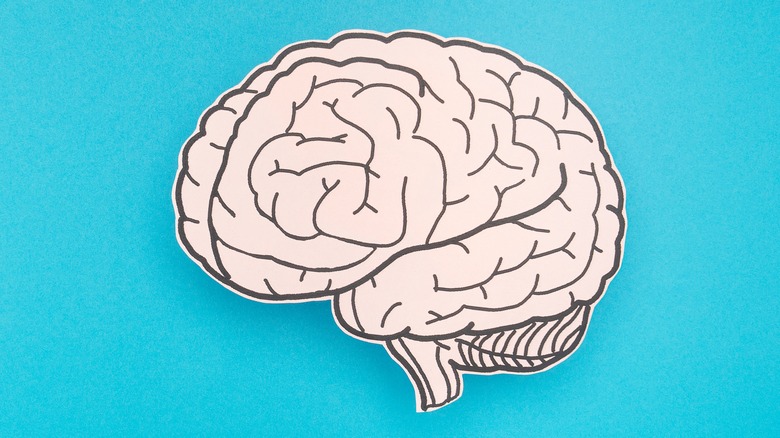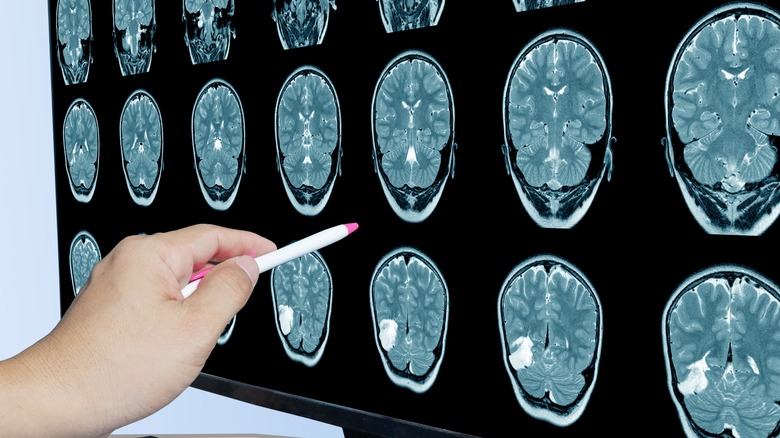Symptoms Of Meningitis You Shouldn't Ignore
It's hard to overstate the seriousness of meningitis. The infection, which is characterized by an inflammation of the tissue around your spinal cord and brain, can develop quickly and become dangerous fast (per the Mayo Clinic).
Meningitis comes in many forms, and while not as common as other diseases in the United States, it still affects a sizeable proportion of individuals each year. Bacterial meningitis is estimated to have a caseload of roughly 2,600 people in the U.S. annually (per the National Organization for Rare Disorders), while viral meningitis may be more common, affecting up to 75,000 people, mainly younger children, each year in the country (per research from StatPearls Publishing). The prognosis of meningitis can be concerning, with around a fifth of people who contract bacterial meningitis facing a potentially severe illness and long-term complications, and death occurring in 10% of cases, says the World Health Organization.
With all this in mind, it's vital to be aware of what meningitis looks like, so that you can get help at the first possible opportunity. But given that this condition is less common than other infections, how do we know how to spot it in the first place? That's where we come in. Let's take a look at the symptoms of meningitis you shouldn't ignore.
There are many different types of meningitis
When discussing meningitis, it's crucial to know that you could be dealing with several different types. While the inflammation around the brain and spinal cord tissue is a constant in all variants of meningitis, it can be caused by many different things (per the CDC). The most serious cause is a bacterial infection, also known as bacterial meningitis. While you may be able to safeguard against some forms of bacterial meningitis, the rapid progression of the disease and the potential danger of its symptoms means that urgent medical attention is required if it's contracted.
Viral meningitis is another form of meningitis caused by infection, which may be prevented in some cases by vaccination. Viral meningitis is usually less severe, though, and recovery is typically easier in a lot of cases. Parasitic or fungal meningitis, while uncommon, are two other forms, caused by parasites or fungal spores entering your airways, respectively. Meningitis may also be caused by factors unrelated to infection, such as trauma, the body's interactions with medication or drugs, and other conditions like cancer that may prompt the inflammatory condition.
Symptoms can vary depending on the type of meningitis someone has, with bacterial and viral meningitis exhibiting different signs (via Familydoctor.org).
A rash can be a clear sign
Of all the symptoms of meningitis, the "meningitis rash" might be the most well known. And that's for good reason, as a rash can be a sign of particularly severe meningitis that requires immediate healthcare.
A meningitis rash is most frequently prompted by infection from meningococcal bacteria, which can prompt a severe meningitis infection (per the Meningitis Research Foundation). The rash occurs due to the damage that the bacteria can cause to your organs and blood vessels once it enters your system. The blood vessels break, creating a rash-like appearance on the skin. The rash may appear as a more consistent block of purple-reddish discoloration (akin to a bruise) or insect bites dotted across the surface of the skin.
Given that a rash can be a sign of a serious infection, if you notice one, it's important to act fast. One way to check whether a rash is with the "glass test." Press a glass against the skin, and if the rash does not disappear or the skin doesn't turn paler, then it's a sign that the rash is because of meningitis. It's worth noting that some cases of meningitis don't exhibit a rash as a symptom, and other cases may have rashes that do blanch when a glass is pressed against them — so remember, it's not the be-all and end-all when it comes to meningitis diagnosis.
Bacterial meningitis can cause cold-like symptoms
While meningitis is a serious and severe condition, it may not always appear so in its early stages. This is especially the case with acute bacterial meningitis which, while remarkably dangerous, may not seem that way upon first contracting it.
In adults and kids, acute bacterial meningitis may just look like a cold initially, with a blocked or runny nose, a cough, and a sore throat being early symptoms (via MSD Manual). A cough may also be an early symptom of viral meningitis, with other cold and flu-like symptoms like a fever or a generalized feeling of being unwell appearing in both forms of the illness (per MSD Manual).
Unfortunately, because these symptoms can be common for a huge range of illnesses, it can be tricky to spot meningitis at this stage of the condition. What you should watch out for, however, is how the disease progresses. If your symptoms rapidly worsen and start to include a stiff neck, confusion or disorientation, and tiredness, medical assistance is needed as soon as possible. The rapid brain swelling that meningitis causes can result in a life-or-death situation in a matter of hours.
Sensitivity to light could indicate meningitis
Sensitivity to light (also known as photophobia), can be a symptom of a range of conditions, from eye infections like conjunctivitis to more serious illnesses like encephalitis (per Healthline). And it's a key sign of meningitis, too, as the Meningitis Foundation points out. This light sensitivity is one of the first signs of meningitis infection, and occurs thanks to the inflammation around the brain and spine that characterizes the illness, according to the experts at TheraSpecs. This inflammation can hamper your brain's ability to process and deal with light, leading to photophobia.
It's worth pointing out that sensitivity to light with meningitis can often appear similar to a migraine, so keep an eye on the other symptoms that meningitis may cause, too. Photophobia can also be a persistent condition after individuals have recovered from meningitis, with light sensitivity potentially continuing to be a problem for years after infection. Headaches that accompany this photophobia can also turn into a long-term issue, and the two combined can create a slew of additional lifestyle challenges. This is why it's so important to try and spot meningitis early on, so it can be treated ASAP.
People with meningitis may be disoriented
If you suddenly start to feel a little confused or disoriented, it could be meningitis. A sudden and unexplained shift in your mood or cognitive processes can be a symptom of meningitis infection and may be one of the earliest you spot, according to Medical News Today. This is due to your brain tissue becoming inflamed and swollen, which can subsequently create a change in cognitive function, states the National Institute of Neurological Disorders and Stroke. A rapid behavior change can also be a symptom.
The neurological changes that meningitis can create are dependent on exactly where the infection affects the brain. Unfortunately, due to the damage that this rapid inflammation can cause, individuals who have meningitis can experience chronic issues with cognitive function after an infection has been treated. Folks who have recovered from meningitis may find it hard to maintain focus or remember things clearly after an infection. In more serious cases, individuals may have learning difficulties. Some cognitive issues may be noticeable or profound if meningitis infection occurs at a younger age, as research published in PLoS One discusses.
A bad headache is a telltale first sign
So, you've suddenly developed a splitting headache. It could be anything, you reason: The fact that you've not drunk enough water today, that extra glass of wine you had last night, the fact that you haven't eaten enough, or even just feeling a bit stressed (per the NHS). But if your headache is especially bad and you can't pinpoint a reason, it could be a sign of meningitis.
The brain and spinal cord membranes (also known as meninges) becoming inflamed can lead to a hardcore headache, which might feel at first as though you have a migraine coming on (via Medical News Today). However, while migraines tend to be localized to one side or area of your head, headaches caused by meningitis tend to cause all-over pain.
A bad headache can be one of the first symptoms of meningitis, as the Meningitis Research Foundation discusses. However, while it's a common sign, keep in mind that some people may have the condition without experiencing a headache, and in other situations, headaches may occur after other symptoms. Nonetheless, if you start to feel the ache, ensure that you get help fast.
Neck pain is a symptom of meningitis
While meningitis symptoms can be vague in its early stages and difficult to diagnose, there's one slightly more specific one you need to watch for: Neck pain.
Whether the cause is viral, bacterial, or of another origin, meningitis produces a large number of its symptoms thanks to the inflammation of the brain and spine membranes it causes, specifically to the dura mater, the upper layer of membrane (per Healthline). Given that this swelling is concentrated around where your brain meets your neck, this can result in stiffness and pain in the area.
Your neck pain may be particularly unpleasant and have a throbbing sensation that goes with general soreness. It may also cause mobility issues, and trying to bend your neck or turn it to the side may be challenging. Your neck pain and stiffness can also come with a pretty severe headache. If the cause of meningitis is bacterial, you'll likely need treatment in a hospital immediately, but milder viral meningitis may be treated at home, following your doctor's advice about which medication to take and how to manage your symptoms. Staying hydrated during this time is essential, as well as resting as much as possible.
Meningococcal meningitis can cause specific symptoms
Meningitis can be caused by many different things, but some of them are more concerning than others. And meningococcal meningitis, a type of bacterial meningitis caused by a bacterium caused Neisseria meningitides, is especially dangerous (per the National Organization for Rare Disorders).
Neisseria meningitides can cause several conditions, with the bacteria also potentially causing septicemia (via the CDC). With meningococcal meningitis, though, there are some key symptoms that you need to look out for due to the condition's steep mortality rate, especially in younger kids and infants. Children may exhibit slower or changed reflexes when they have meningococcal meningitis, and babies may have trouble with feeding normally, says the CDC. Your baby may also seem more irritated or be moving more slowly than usual. In adults, meningococcal meningitis tends to reveal itself through a fever, often accompanied by a headache and a stiff or painful neck. You may also feel sick or start to vomit. Meningococcal septicemia, on the other hand, tends to cause cold extremities, notable muscle pain, and diarrhea alongside fever and potential chills.
If you contract meningococcal meningitis, a course of immediate antibiotics is utterly essential, according to the National Organization for Rare Diseases. Failing to receive antibiotic treatment will result in death.
In babies, look out for a bulge on the head
Diagnosing conditions in babies can be more challenging for some people, thanks to the fact that babies are unable to explain their symptoms. But when it comes to meningitis, one symptom is especially important to keep an eye out for.
Babies with meningitis may exhibit a telltale bulge on their heads, in the soft spot known as the fontanel (via Medical News Today). The fontanel, which is the area where the bones have yet to fully cohere, is usually slightly concave, but when meningitis causes brain swelling, this area bulges out.
With that said, if your baby's head has a bulge, it may not necessarily be meningitis. In fact, research published in the European Journal of Pediatrics points out that the majority of causes of a bulging fontanelle are "self-limiting diseases," with a fairly low incidence of an association between a bulging fontanelle and bacterial meningitis. Despite this, a raised soft spot on your baby's head should never be ignored, as it could indicate a serious condition that requires urgent medical assistance.
Tiredness can be a symptom
For a lot of people, between work, socializing, and picking up the kids, a little tiredness is a fact of life. But starting to feel tired for seemingly no reason could be a sign of something a little more serious. Tiredness and sluggishness that seems to appear out of the blue could be a symptom of meningitis, states WebMD. A significant drop in energy could also indicate meningitis in younger children and infants, so if you notice that your little one is a little less vibrant than usual, make sure you investigate properly.
Unfortunately, this tiredness can persist once someone is over their initial stages of meningitis, as the Meningitis Research Foundation states. Adults can continue to feel fatigued during recovery, making adjustments to their schedule and lifestyle necessary. They might find it helpful, for example, to slowly reintroduce themselves to work or their day-to-day activities, and not overexert themselves.
It's equally important to remember that while fatigue is a sign of meningitis, it's also a symptom of a huge range of conditions, from liver disease to hyperthyroidism to depression (per Healthline). As such, it's important not to jump to conclusions — but you also shouldn't ignore your fatigue.
Individuals with meningitis may lose their appetite
Noticing that you're feeling a little less peckish today? That could be a sign of meningitis. A loss of appetite is a fairly general symptom that could be prompted by many things (per the Cleveland Clinic), but in people with meningitis, it's due to how the illness interacts with your central nervous system (via Healthline). The swelling of the meninges around parts of your central nervous system (your spinal cord and brain) can result in a change to your body stasis and produce a fever. It's this reaction that makes you lose your appetite — and prompts a host of other symptoms, too.
Loss of appetite is also a common symptom in children and babies that have meningitis, as the American Academy of Pediatrics states. You might find that your baby is finding it hard to feed, or is reluctant to feed as normal. If you or your child contract bacterial meningitis, you may be placed on a course of fluids alongside your treatment to top up any lost when you were unable to eat, according to KidsHealth. Upon recovery from meningitis, your child may have a poor appetite for a while (which can often be influenced by anxiety as much as the illness itself), but the good news is that their normal appetite should return after a while (per Netdoctor).
You might experience hearing loss
Meningitis is a complex condition that causes an enormous breadth of symptoms, thanks to the impact the illness has on your brain and spinal cord (per WebMD). And one of the slightly more surprising symptoms you may experience is hearing loss. Hearing loss can occur when someone has meningitis due to your cause of infection (be it viral or bacterial) impacting different parts of the body. "Extension of the infection into the inner ear structures including the cochlea and the auditory nerve" may result in a change or loss in your aural ability, says Los Angeles-based otolaryngologist Ronen Nazarian.
Changes or loss in hearing may be more likely depending on your age, with under-25's and people older than 65 most commonly being affected with the symptom. Unfortunately, hearing loss can persist after recovery from meningitis, and can be an issue specifically with bacterial meningitis. In children, in particular, hearing loss could be permanent in up to a third of cases after having bacterial meningitis, according to research published in the Archives of Otorhinolaryngology-Head & Neck Surgery. Roughly 4% of children with bacterial meningitis may also develop profound bilateral hearing loss, where both ears are affected and the majority of hearing capability is lost (per the CDC).
Bacterial meningitis may cause seizures and loss of consciousness
Meningitis is a condition that can have a fast progression. And while symptoms may appear mild and potentially cold-like at first, things can quickly escalate into a far more serious situation.
People with bacterial meningitis can experience seizures, even after being admitted to the hospital and undergoing treatment, states research published in Neurology. Seizures are, in fact, a relatively common symptom, with approximately 17% of patients experiencing at least one — and unfortunately, they're also an indicator that bacterial meningitis could be particularly serious, with death more likely in individuals having seizures.
Loss of consciousness and falling into a coma is another highly dangerous consequence of acute bacterial meningitis (via MSD Manual). Individuals who become comatose may have to be mechanically ventilated, while those who have seizures might have to be placed on antiseizure medication. These two grave symptoms point to the paramount importance of trying to spot meningitis early and receiving treatment as soon as possible. As research published in The Lancet points out, diagnosing bacterial meningitis early on and administering treatment for it quickly is a major factor in the likelihood of surviving the condition.
How is meningitis treated?
While meningitis can be a serious condition, the good news is that there are ways to treat it. The avenue for treatment, though, depends on the type of meningitis you have.
Meningitis is generally diagnosed by your doctor by looking for specific symptoms and signs and potentially running blood tests, CT scans, or spinal taps (per the Mayo Clinic). If your meningitis is bacterial, you'll need to be treated instantly. Your doctor will typically deliver a course of antibiotics, usually intravenously, and corticosteroids may also be prescribed to keep the swelling around your brain and spinal cords down. Given the severity of bacterial meningitis, you may be admitted to the hospital for this treatment.
Viral meningitis, on the other hand, can be less severe, and treatment might be less involved. Generally, you'll be required to stay hydrated and rest until the viral infection passes. Antiviral medication is usually not required unless the meningitis is caused by a herpes virus, but pain medication or corticosteroids may be used to bring down inflammation, fever, and aches. When meningitis is caused by another condition, like cancer, treatment for the root cause is the best way to go, although corticosteroids may still be used to control swelling and symptoms.















